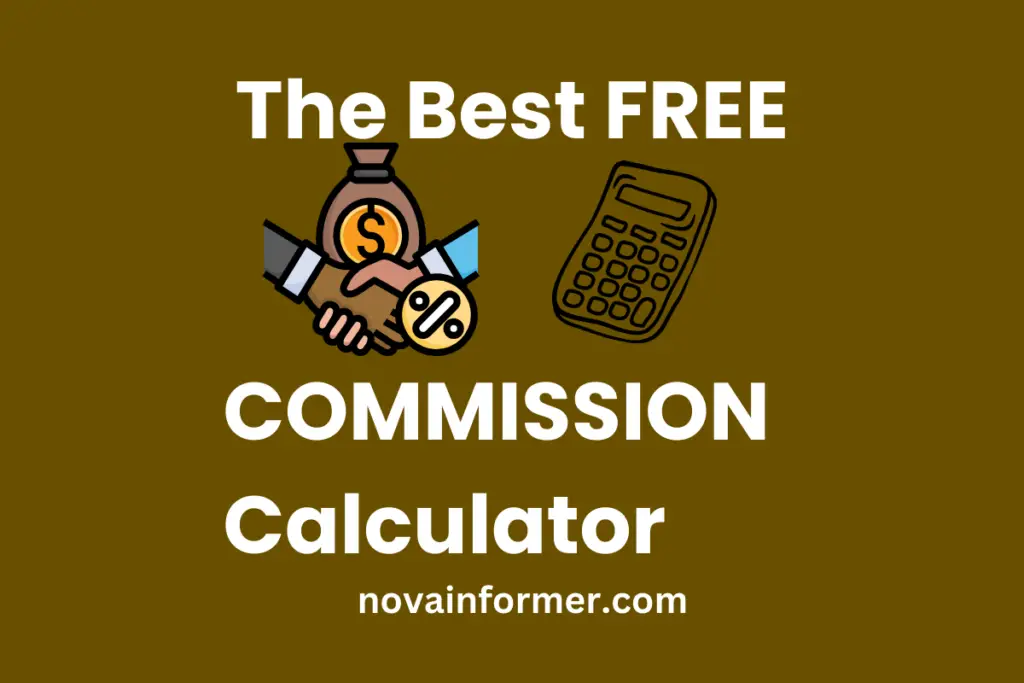Want to know how much commission you will get? Use our awesome commission calculator.
Results
In the fast-paced world of business, understanding commissions is like mastering a secret language that opens doors to financial success.
This guide will not only unravel the mysteries of commissions but also introduce you to the magic of the Commission Calculator, a tool that can transform your financial game.
So, buckle up for a journey into the heart of commissions and learn how to navigate this landscape like a seasoned pro.
Key Takeaways
- Commissions are powerful motivators driving performance and sales.
- Different commission structures cater to diverse business needs.
- The Commission Calculator streamlines calculations for quick and accurate results.
- Designing an effective commission structure requires careful consideration of various factors.
- This article provides practical insights, examples, and a step-by-step guide on using the Commission Calculator.
Understanding Commissions
Introduction to Commissions
Welcome to the world of commissions – the fuel that powers sales and elevates individuals and businesses to new heights.
Think of commissions as a reward system, where your hard work translates into tangible financial gains. Imagine closing a deal, and like a victorious knight, you’re granted a share of the treasure chest.
Why Commissions Matter
Picture this: you’re on a road trip, and every mile you cover adds to your pocket. That’s the essence of commissions. They matter because they turn effort into earnings, creating a direct link between your performance and your paycheck.
Commissions act as a dynamic force, aligning your personal goals with the success of the company. It’s not just about making a sale; it’s about reaping the rewards of your dedication.
Types of Commissions
Commissions come in various flavors, each suited to different tastes. Let’s break it down:
- Fixed Commissions: Think of these as your steady paycheck in the commission world. They provide stability, ensuring a consistent income regardless of fluctuations in sales volume. This structure is often seen in industries with predictable revenue streams.
- Variable Commissions: Imagine a commission structure that adapts to your performance, like a chameleon changing colors. Variable commissions are flexible, offering a percentage of the sale, making them highly motivating. The more you sell, the more you earn – a simple equation with powerful implications.
- Hybrid Commissions: Now, picture a commission structure that combines the best of both worlds. Hybrid commissions offer stability through a fixed base while incorporating performance-based incentives. It’s like having a safety net while still enjoying the thrill of reaching higher earning brackets.
Understanding these commission types allows businesses to tailor their incentive programs to the specific needs and dynamics of their industry.
Commission Calculator: A Game-Changer
Enter the Commission Calculator, your trusty sidekick in the world of numbers. This tool transforms complex calculations into a simple, user-friendly experience.
It’s not just a calculator; it’s your financial ally. When armed with the Commission Calculator, you’re equipped to navigate the financial landscape with confidence, knowing that accurate results are just a few clicks away.
How to Use this Commission Calculator
Using the Commission Calculator is as easy as ordering your favorite pizza. Here’s your step-by-step guide:
- Input Sale Price: Begin by entering the sale price in dollars. This is the monetary value of the deal you’ve closed.
- Adjust Commission Percentage: Use the slider to set the commission percentage. This percentage represents the portion of the sale that you’ll earn as a commission.
- Witness the Magic: Once you’ve set the parameters, watch as the calculator reveals your commission amount and total commission. It’s like having a financial crystal ball that shows you the rewards of your hard work.
Now, armed with the basics, let’s explore the art of creating effective commission structures.
Creating an Effective Commission Structure
Designing an Ideal Commission Structure
Crafting the perfect commission structure is like concocting the ideal potion – it requires precision and the right ingredients. Here’s a closer look at the elements you should consider:
Industry Standards
Research prevailing commission rates in your industry, ensuring your structure aligns with market norms. Industry standards serve as a compass, guiding you toward a structure that is both competitive and fair.
For example, if your industry typically offers a 10% commission rate, straying too far from this norm may result in dissatisfaction among your sales team.
Sales Goals
Set achievable and motivating sales targets, creating a roadmap for your team to follow. Sales goals are the compass that directs your team toward success.
These goals should strike a balance between being challenging enough to spark motivation and realistic enough to be attainable. Think of them as the milestones that, when reached, trigger the release of well-deserved commissions.
Performance Metrics
Define clear performance metrics, so everyone understands the rules of the game. Performance metrics act as the rulebook for your commission structure.
Whether it’s the number of sales, the revenue generated, or customer satisfaction scores, clarity is key. When everyone is on the same page regarding expectations, it fosters a sense of fairness and transparency.
Team Collaboration
Encourage teamwork by incorporating team-based incentives, fostering a collaborative spirit. While individual performance is crucial, teamwork can elevate the entire ship. Consider incorporating team-based incentives to encourage collaboration.
This could involve setting collective sales targets or rewarding teams that consistently outperform expectations. The result? A motivated and cohesive team working toward shared success.
| Element | Consideration |
|---|---|
| Industry Standards | Research prevailing commission rates in your industry. |
| Sales Goals | Align commissions with achievable and motivating sales targets. |
| Performance Metrics | Define clear performance metrics for commission calculations. |
| Team Collaboration | Encourage teamwork by incorporating team-based incentives. |
Commission Calculator in Action
Let’s dive into a real-life scenario to understand how the Commission Calculator works. Imagine you’re a sales superstar who just closed a deal worth $10,000.
With a 15% commission rate, the calculator swiftly determines that your commission amounts to $1,500. This isn’t just a number; it’s a tangible representation of the rewards awaiting you for your hard work and dedication.
Common Mistakes to Avoid
Avoiding pitfalls is as crucial as chasing success. Here are some common mistakes to steer clear of:
- Ignoring Industry Standards: Setting commissions drastically above or below industry norms can demotivate your team. It’s like offering too much or too little seasoning in a dish – balance is key.
- Lack of Transparency: Communicate how commissions are calculated to prevent confusion and resentment. Transparency is the cornerstone of a healthy commission structure. When your team understands how their earnings are determined, it fosters trust and engagement.
- Overcomplicating Structures: Keep it simple. A convoluted commission structure may discourage rather than motivate. Complexity often breeds confusion. A simple and transparent structure ensures that your team can easily grasp the rules of the game.
Crafting Effective Commission Structures: A Deep Dive
Welcome back to our exploration of the captivating world of commissions. In Part 1, we uncovered the fundamentals, from the motivational force of commissions to the magic of the Commission Calculator.
Now, let’s embark on a deeper journey, delving into the intricate art of crafting effective commission structures that propel individuals and teams toward success.
The Art of Commission Crafting
Understanding Individual Motivations
In our quest for the perfect commission structure, understanding what motivates individuals is paramount. Imagine each team member as a unique character in a story, each with their own strengths and preferences.
Tailoring your commission structure to accommodate these diverse motivations ensures a well-rounded and motivated team.
Incorporating Performance Tiers
Picture a gaming realm where each level conquered brings greater rewards. A commission structure with performance tiers introduces a sense of achievement and progression.
It’s like offering different challenges to your team, where reaching specific sales milestones or consistently exceeding targets results in ascending through performance tiers. This keeps the journey exciting and provides clear goals for improvement.
Table 1: A Simple Example of a Tiered Commission Structure:
| Sales Targets | Commission Rate |
|---|---|
| Up to $10,000 | 10% |
| $10,001 – $20,000 | 12% |
| $20,001 and above | 15% |
Balancing Individual and Team Incentives
The delicate balance between individual achievement and team success is the hallmark of a well-crafted commission structure. While recognizing individual efforts is crucial, incorporating team incentives fosters collaboration.
Consider a scenario where achieving collective team goals unlocks additional bonuses for all members. This not only strengthens teamwork but also enhances the overall performance of the entire group.
Introducing Special Performance Bonuses
Imagine finding hidden treasures along your journey. Special performance bonuses can be tied to extraordinary achievements, such as surpassing annual targets or securing high-profile clients.
By introducing occasional windfalls, you add an element of surprise and excitement to the commission structure. It’s like discovering unexpected rewards for exceptional feats.
Table 2: Example of Special Performance Bonuses:
| Achievement | Bonus Amount |
|---|---|
| Surpassing Annual Sales Target | $5,000 |
| Securing High-Profile Client of Month | $2,000 |
| Exceeding Quarterly Growth Rate | $3,500 |
Tailoring Structures to Industry Dynamics
Navigating the diverse landscapes of different industries requires a customized approach. An industry steeped in long sales cycles may benefit from a mix of fixed and variable commissions to sustain motivation over time. Conversely, industries with shorter sales cycles might find pure variable commissions more suitable. Adapting your commission structure to industry dynamics ensures relevance and effectiveness.
Practical Examples Using the Commission Calculator
Example 1: Tiered Commission Structure
Consider a sales team with the following tiered commission structure:
Scenario:
- Sale Price: $25,000
- Commission Rate: 10%
Calculation:
- Commission Amount = $25,000 * 10% = $2,500
In this scenario, the Commission Calculator swiftly computes the commission, making the process seamless and efficient.
Example 2: Team Incentives
Imagine a scenario where a team achieves a collective sales target, unlocking a team bonus. The team closes deals totaling $200,000 in a month, triggering a bonus of $5,000. The calculator ensures fair distribution among team members based on their contributions.
Example 3: Special Performance Bonus
A salesperson exceeds quarterly growth expectations, qualifying for a special performance bonus of $3,000. The calculator accurately determines this additional reward, celebrating the individual’s exceptional achievement.
Common Questions About Commission Structures
Can commission structures be adjusted over time?
Yes, commission structures can and often should be adjusted to reflect changes in business goals, industry dynamics, and team feedback.
How do you handle disputes over commission calculations?
Establish a transparent process for dispute resolution, involving clear documentation and open communication. This ensures fairness and clarity.
Are there legal considerations when designing commission structures?
Absolutely. It’s essential to comply with labor laws and ensure that your commission structure aligns with legal requirements in your jurisdiction.
What’s the best way to communicate changes in commission structures?
Transparent communication is key. Clearly communicate any changes, providing ample time for the team to adapt and addressing concerns openly.
Should commission structures include non-monetary incentives?
Yes, non-monetary incentives, such as recognition, career advancement opportunities, or special privileges, can enhance the overall effectiveness of a commission structure.
How can you ensure that a commission structure remains motivating in the long term?
Regularly evaluate and adjust the commission structure to align with evolving business goals and individual motivations. Keeping it dynamic ensures sustained motivation.
Can commission structures be too complex?
Absolutely. Strive for simplicity. A complex structure may confuse and demotivate the team. Clear and straightforward rules lead to better understanding and motivation.
Is it advisable to seek input from the team when designing a commission structure
Yes, involving the team in the process fosters a sense of ownership and ensures that the structure reflects the diverse motivations within the group.
Now, lets us address frequently asked questions about commissions.
Frequently Asked Questions About Commissions (FAQs)
Curious minds often seek answers. Here are some FAQs demystifying commissions:
How are commissions different from bonuses?
Commissions reward specific sales performance, while bonuses are discretionary rewards for overall achievements. It’s like earning a bonus for winning a particular battle, while commissions are the spoi of each successful skirmish.
Can commissions be negotiated?
In some cases, yes. Negotiation depends on industry norms and individual circumstances. It’s akin to a friendly negotiation at the marketplace – finding the right balance that satisfies both parties.
Are commissions taxable?
Yes, commissions are taxable income. Include them when filing your taxes. Consider it as paying your dues to the kingdom in return for the treasures you’ve acquired.
How often are commissions paid?
Payment frequency varies, with monthly, quarterly, or one-time lump sums being common. It’s like choosing how often you want to receive your loot – regular intervals or a grand accumulation.
What happens if a sale is refunded or canceled?
Policies differ, but commissions earned on refunded or canceled sales may be deducted from future earnings. It’s like returning a portion of the treasure when a deal unravels.
Are there industries where commissions are not common?
While prevalent in sales, some sectors, like nonprofits, may not use commission structures. It’s like exploring different kingdoms, each with its own set of rules and rewards.
Can commissions be clawed back?
Yes, some companies have clawback provisions, reclaiming commissions under specific conditions. It’s a bit like the kingdom taking back a portion of the treasure if certain agreements are not upheld.
Is there a legal requirement for commission structures?
Laws vary, but in some jurisdictions, regulations ensure transparency and fairness. It’s like having a royal decree that dictates the rules of engagement – ensuring a fair distribution of rewards.
In Conclusion
In the realm of business, commissions serve as the guiding stars, transforming hard work into tangible rewards. Our journey explored the significance of commissions, the magic of the Commission Calculator, and the art of crafting effective structures.
From understanding individual motivations to introducing performance tiers and team incentives, a well-designed commission structure becomes the compass leading teams toward success.
As we conclude this chapter, remember to navigate the commission landscape with confidence and purpose.
credit:
Perplexed Coder (https://codepen.io/adi142857/pen/bGwOdBV)



